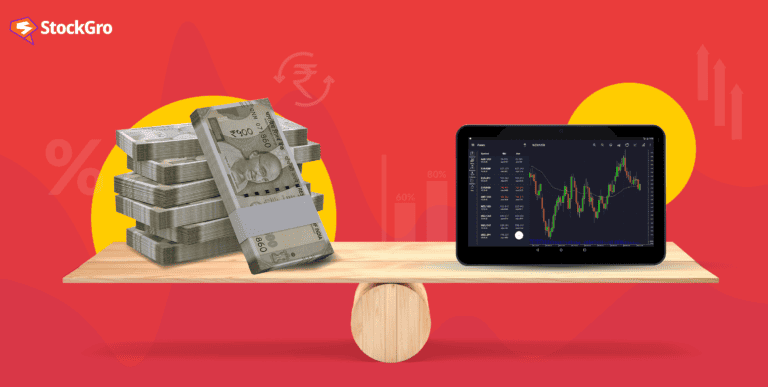
In the stock market, financial leverage unfolds a deck of risk and reward. Financial leverage means utilising external capital to boost potential profits rather than what could be gained using only own capital.
Alluring to most market participants, leverage trading is an intriguing concept that has the potential to turn modest investments into substantial positions.
However, this potential of magnifying gains is accompanied by the risk of amplified losses. Using leverage demands skilful tactics with an unwavering focus to prevent potential losses and increase the odds of securing profits.
This exploration seeks to offer a thorough understanding of leverage. It can help our readers get familiar with leverage mechanisms’ intricacies.
Let us help you to understand the meaning of leverage, explore its potential pitfalls and how equip yourselves with the knowledge required to navigate the complexities of leverage in the stock market.
What is leverage in the stock market?
Leverage in the stock market refers to the ratio by which a trading position is magnified than the capital you put up as margin. In another way, the leverage ratio is the measure of a trader’s total market exposure against a margin.
Margin is a percentage of the total trade amount required to take a position in the market.
For example, the leverage is 10:1. This ratio shows that you employ one-tenth of the actual trade amount as a margin. So, if you want to trade Rs. 1 lakh, you need to pay only Rs. 10,000 in margin.
Leverage is used across financial markets to trade varied securities, including stocks, commodities, forex, exchange-traded funds (ETFs), etc., subject to rules and regulations in India. Let us move to leverage trading after this exploration of leverage ratio meaning.
You may also like: Hedging 101: Protect your investments from market surprises
Exploring leverage trading
Leverage trading refers to an act of taking positions in financial markets using borrowed funds. It is an effective strategy to control a larger position using a small portion of your capital. There are several ways to utilise leverage trading in financial markets. Two widely used techniques are margin trading and options trading.
- Margin trading
Margin trading involves borrowing funds from a stockbroker at an interest rate to increase the exposure with a trading position.
For example, if a trader offers 3:1 leverage, you can initiate a trade of Rs. 30,000 with a capital of just Rs. 10,000 from your own money and Rs. 20,000 borrowed from the broker. If the trade goes in a favourable direction, it can increase profits. Conversely, if the trade goes against your analysis, you have to pay the borrowed funds, interest on it, and bear the losses beyond the initial investment. Margin traders require a margin trading account to utilise leverage.
- Options trading
Another way is options trading, where traders use financial derivatives – options contracts – to trade using leverage. Options are a privilege for traders as they grant the right, but not the obligation, to buy or sell an underlying security at a preset price on or before it expires.
While leverage trading amplifies the potential returns of investments, it carries an increased risk of potential losses. Therefore, understanding the associated risks with leverage trading is paramount.
Significance of leverage for traders
Here are the key benefits of leverage, indicating the significance of leverage for traders:
- Access more investment opportunities: With leverage, traders can partake in more substantial trades or allocate capital to multiple trade positions.
- Significant gains in successful trades: Individuals utilising leverage trades can gain substantially when trades go well in the anticipated direction.
- Grabbing short-term opportunities: Sometimes, market fluctuations offer short-term trading opportunities that traders need to grab quickly.
- Defying price tag limitations: Leverage disrupts the scenario of hefty prices and allows you to trade desired securities with a high potential for profits.
Understanding the risks and challenges of leverage trading
- Margin calls: When the value of a margin trader’s margin account falls below the required margin, brokers can make margin calls. You need to fund the account to avoid liquidating assets at low prices, potentially increasing the margin trade losses.
- Market fluctuations or downturns: Leverage can erode the invested capital in no time as it amplifies losses, especially if strategies do not back margin trades.
- Interest and fees associated with leverage: There can be other fees levied on margin trades, which can add to the overall cost of leverage trading.
- Excessive use of leverage: When the leverage ratio does not align with an individual’s risk profile and availability of funds to meet losses, it heightens the risk involved in leverage trading.
Also Read: Power your investment portfolio with growth stocks
Best practices while engaging in leverage trading
Following are a few best practices that can be helpful for traders to achieve success in leverage trading:
- Understanding the comfort zone in leverage trading
Gauging risk appetite is a personal evaluation based on financial stability, psychological temperament to face losses, and overall willingness to bear losses.
Traders must consider using the capital for leverage trades that do not push them towards compromising their financial state. Understand your psychological state to respond to losses.
- Start with small leveraged positions
Starting small with leveraging allows traders to understand how it impacts their trades without exposing their funds to high risk.
New entrants in the stock market can consider modest leverage levels., especially if their risk appetite does not allow it.
- Ensure to utilise sop loss to safeguard your trades
Setting a stop loss allows traders to define the maximum loss traders can bear on a trade. It can help traders to prevent a loss from becoming a substantial one.
- Consider time horizon
Identify if you need short-term gains or long-term growth is your focus. Different trading approaches and leveraged products carry different levels of risk.
Also Read: Option chain for smarter online trading
- Research-based diversification
A research-based approach to diversification begins with a deep understanding of leveraged products. Look at their historical performance and market trends to evaluate risk and potential return. Leverage a trade only if you are sure about the stock price directions.
The closing
The allure of leverage lies in the prospect of amplifying gains, but it can also amplify losses within a blink of an eye. Exposing to appropriate positions in the stock market, practising diversification, and having a clear risk profile is vital for prudent risk management while considering leverage.

